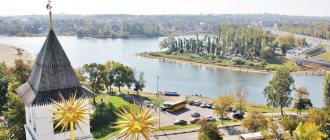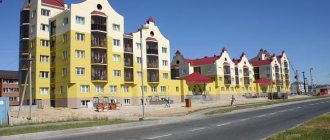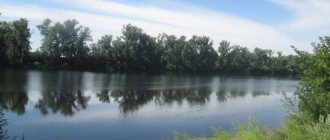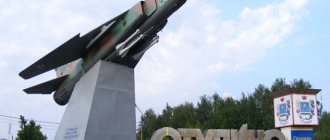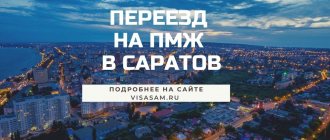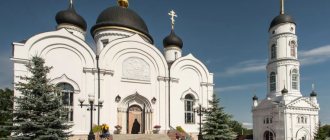Novosibirsk – the administrative center of the Novosibirsk region, the unofficial capital of Siberia, the official center of the Siberian Federal District (Siberian Federal District) and the municipal formation of the Novosibirsk region. The key city of “Big Novosibirsk”, the Novosibirsk agglomeration, which also includes the cities of Ob, Iskitim, Berdsk and the villages of Koltsovo and Krasnoobsk.
Novosibirsk is located on the right and left banks of one of the largest rivers of the Russian Federation - the Ob, on the Priobsky plateau in the south-eastern part of Western Siberia, near the Novosibirsk reservoir, Kudryashovsky and Zaeltsovsky forests, at a distance of 3191 km from Moscow.
The city is the third most populous in Russia and ranks twelfth in area with an area of 502.7 km².
On September 23, 1983, Novosibirsk was awarded the Order of Lenin.
History of Novosibirsk
Novosibirsk is a young and rapidly developing city. Its history is an amazing combination of events that intertwined into a single mosaic, which led to the birth of one of the symbols of the greatness of Russia. The beginning was made in 1891, when Emperor Alexander III issued a decree on the start of construction of the Trans-Siberian Railway (original name - Siberian Road), which was supposed to connect Chelyabinsk (Southern Urals) and Vladivostok (Far East).
In 1893, one of the great and legendary people of that time, Minister of Finance Sergei Yulievich Witte, proved the feasibility of building a railway bridge across the Ob River in the area of the village of Krivoshchekovo, where the ruins of the Teleut fortress were located on the right bank. No sooner said than done, on April 30, 1893, engineer G.M. arrived from Kolyvan. Budagov, and the construction of engineering structures and a workers’ camp for bridge builders began. This is how Novosibirsk was born.
Initially, the village was named Aleksandrovsk in honor of the emperor, but four years later (02/17/1898) it was renamed Novonikolaevsk (Novo-Nikolaevsk) in honor of the last emperor Nicholas II. Novosibirsk received its modern name on February 12, 1926.
Main historical milestones of the city:
- On December 28, 1903, by rescript No. 747-47, signed by Emperor Nicholas II, it acquired the status of a city without a district;
- 12/11/1908 – awarded the status of a full-fledged urban settlement;
- 04/17/1917 - becomes a district and becomes part of the Tomsk province (it could have become a provincial center, the center of the Altai province in 1916, but it did not work out);
- 12/23/1919 - became the provincial center of the Tomsk province;
- 13.06. 1921 – acquired the status of a provincial city in the Novonikolaevsk province;
- 05.25.1925 – after the formation of the Siberian Territory, it was given the status of an administrative center;
- 07/30/1930 - as a result of territorial and administrative reform, it was transformed into the center of the West Siberian Territory;
- 09.28.1937 – acquired the status of a regional center of the newly formed Novosibirsk region;
- 08/21/1943 – withdrawn from regional subordination and becomes a separate administrative structural unit under republican subordination;
- 07/03/1958 – return to regional subordination with the status of a regional center;
- 09/02/1962 – 70 years after its founding, it becomes the youngest city in the world with a million population;
- 05/13/2000 - by presidential decree, it was given the status of an administrative center of the Siberian Federal District (Siberian Federal District).
The intensive development of Novosibirsk was associated with its favorable geographical location, the intersection of water transport routes (the Ob is a navigable river) and the Trans-Siberian Railway. This ensured the rapid growth of trade, banking and industry.
During the Soviet years, this trend intensified largely due to industrialization and the city’s status as the center of the Siberian region, which made it possible to concentrate significant financial and economic resources in Novosibirsk. The impetus for the development of the city was the Great Patriotic War. In the post-war period, Novosibirsk became one of the largest scientific centers in the country, and industry acquired a distinct defense specificity.
In the 90s of the last century, industrial production focused on the defense industry collapsed and decreased at a precipitous rate. Now Novosibirsk is developing dynamically, has turned into a large trade and financial center and has managed to maintain its scientific base in difficult years, which allows us to look into the future with hope.
Temples
The main temple of the city is the Ascension Cathedral, which was built in 1913. This was the first wooden temple in the city. Today, services are held daily in the Ascension Cathedral, which every believer can attend.
One of the oldest cathedrals in Novosibirsk is the Alexander Nevsky Temple. Emperor Nicholas II provided assistance in the construction of the temple; it was he who allocated a plot of land for the construction of the temple.
Climate of Novosibirsk
The climate of Novosibirsk is distinctly continental, with characteristic significant differences (jumps) in temperatures within 38°C, which is very significant. Therefore, the comfort of living in the city is low. The picture is complemented and aggravated by squally winds, which are not uncommon in these places.
Main climatic characteristics:
- air temperature (average annual) + 1.8 ° C;
- average temperature in July +19 ° C;
- the average temperature in January is 16 ° C;
- historical minimum temperatures -51.1 °C (January 1915);
- historical maximum temperature + 40.8 ° C (07/12/2014);
- average annual precipitation – 400 mm;
- the winter period lasts 5-6 months (winter can last up to 165 days, very severe and long, with squally winds, snowstorms and stable snow cover);
- the summer period lasts 2-3 months (summer is short, on average 87 days, hot, begins at the end of May and ends at the end of August);
- transition periods spring and autumn are very short and characterized by very unstable weather;
- average wind speed – 4 m/s.
In general, compared to the climatic conditions of the settlements of the American continent located in these latitudes, the climate of Novosibirsk is less severe, but not for sissies.
National composition
Ethnic composition is an indicator that shows how many representatives of different nationalities live. Current data is the results of the All-Russian Population Census 2010. The next census will be conducted in winter 2022.
2010 data
The largest national group is Russians, the share is 92.8% of the total number of people. The second position is Ukrainians. Representatives of this nationality account for 0.92%. Third position – Uzbeks – 0.75%.
0.73% of the population in Novosibirsk today are Tatars. 0.63 percent are Germans. 0.61% are Tajiks. The next ethnic group is Armenians, whose share is 0.47 percent. The next ones are Kyrgyz – 0.44 percent of the townspeople.
0.41 percent is the share of Azerbaijanis. Next come Belarusians – 0.24%. 0.2% – Kazakhs, Koreans. Yazidis make up 0.16% of the population in Novosibirsk as of 2010. The next ethnic group is Jews – 0.15 percent.
The next largest people are the Chinese, making up 0.13%, followed by the Roma – 0.1 percent. Buryats and Tuvans account for 0.09% each, Chuvash and Georgians 0.07%. 0.05% – Turks, Mordovians. 0.04% – Yakuts, Bashkirs, Poles, Altaians, Moldovans.
It can be concluded that the ethnic composition of the settlement is quite diverse, with many indigenous peoples of Asia living there.
Ecology of Novosibirsk
The ecology in the city is ambiguous. On the one hand, natural forests have been preserved in Novosibirsk itself and its suburbs, plus such recreational resources as the Ob reservoir, the Ob, and many small rivers and lakes. On the other hand, the city is a large industrial center with a developed chemical industry, a metropolis with about 1.5 million inhabitants, which negatively affects the environmental situation.
Air pollution in the city is associated with factors such as:
- road transport (66%);
- thermal power plants (25%);
- industrial enterprises (4.5%);
- boiler rooms (4%);
- individual heating.
Emissions into the atmosphere amount to 300 – 360 thousand tons per year.
The main pollutants are:
- formaldehyde (from 3 to 4.6 MAC);
- benzopyrene (up to 3.1 maximum permissible concentration);
- nitrogen dioxide (from 1.2 to 1.5 MPC);
- ammonia (up to 1.3 MPC);
- hydrogen fluoride (up to 1.2 MPC);
- dust (up to 1.3 MAC).
Soil pollution is associated with two factors:
- radiation situation;
- waste generation.
Within the city there are several enterprises and institutes of the nuclear industry, so in some areas (there are about 217 of them) the background radiation significantly exceeds the maximum permissible standards. Although most of these facilities are no longer functioning. The most difficult situation is in the Kalininsky region, at the chemical concentrates plant (the presence of such carcinogenic substances as methylene chloride, benzene and carbon tetrachloride was discovered in the atmosphere there).
The situation is aggravated by the fact that 8 out of 10 districts of the city are located on a granite massif with a high content of uranium-238 and radon-222, which increases the level of natural radiation and can lead to serious diseases.
The volume of solid household waste is 2 million cubic meters, industrial waste - 500 thousand tons. Moreover, some of the waste ends up in unorganized landfills (there are about 170 of them in Novosibirsk, with a total area of 14 hectares), located on the banks of rivers and ravines, which significantly worsens the environmental situation in the city.
The situation with water resources is also difficult. The Ob Reservoir receives contaminated water from other regions. Surface flow is 65 million cubic meters per year, which is why the following flows into the main water artery of the region:
- suspended substances (27 thousand tons per year);
- petroleum products (1.2 thousand tons);
- floating substances (1 thousand tons, including biogenic, organic substances and chemical compounds).
It should be taken into account that the main water intake to meet the drinking water needs of the population is taken from the Ob River. In general, thanks to significant financial resources and targeted programs, the environmental situation in Novosibirsk is improving every year, as evidenced by the fact that the city is already in 50th place in the environmental development rating of Russian cities, and is not at the bottom of the list.
Popular message topics
- Nobles in ancient Egypt
Egypt has kept many secrets to this day. A state that has a rich history, which historians and scientists are still trying to understand. This state has always adhered to a model of government in which the ruler had absolute influence - City of Orel
The city of Orel was founded as a fortress during the reign of Ivan the Terrible in 1566. The fortress was located along the banks of the Oka River. She was defensive in nature. Later it became the center of Oryol district. - Ecology of housing
Housing ecology is one of the sections of urban ecology that studies human life directly in his house or apartment. Since a person spends a significant part of his life there, it is very important to maintain housing in a condition
Population of Novosibirsk
Novosibirsk is a unique, third largest city in the Russian Federation, from a working-class village in 100 years it has turned into a metropolis with a population of one and a half million. It was one of the fastest growing cities in the world, which is reflected and recorded in the Guinness Book. The population of the city as of January 1, 2019 is 1,618,039 thousand inhabitants. This is 70 thousand more than in 2014.
The population density of Novosibirsk is about 3 thousand people per 1 km2. Population growth dynamics are positive, which is due to:
- a decrease in mortality compared to birth rates (18,383 people versus 20,792 babies);
- pendulum migration.
Natural increase – 2409 people (14th place among cities of the Russian Federation).
The natural increase rate is 1.5%. Migration exists:
- intraregional, due to the influx of rural population to the regional center;
- international (thanks to the favorable geographical location and powerful economic development of the region, a large influx of labor migrants, including illegal ones, has emerged from the CIS countries, Central and Southeast Asia, China, Kazakhstan, Ukraine).
- In 2022, population growth amounted to 6 thousand people
The population structure is as follows:
- working population more than 64% (965,616 people, largely thanks to labor migrants);
- children – 14% (230,678 people);
- pensioners – 22% (351,616 people).
As in many other regions of the Russian Federation, the female population of Novosibirsk predominates over the male population. The ratio is 835,570 to 712,190 citizens, or a percentage of 55% to 45%.
The number of marriages exceeds the number of divorces, 14,627 versus 7,910; according to these indicators, Novosibirsk confidently ranks 3rd in the Russian Federation. About 75% of marriages break up, but many spouses re-create families after realizing their mistakes. The main age category of those getting married is 20-34 years old, there is a trend towards aging marriages; just a few years ago the age category was 18-24 years old.
The national composition is homogeneous. The majority of the population (1,269,979 people or 92.82% of the total population of the city) are Russians. Other nationalities are represented insignificantly and occupy no more than 1% in the structure of the national composition of the metropolis. The most represented are Ukrainians, Tatars, Germans, Tajiks and Uzbeks. A significant difference is observed in the ratio of men and women by nationality. Thus, among Russian Novosibirsk residents there are 81 men per 100 women, and among the Chinese living in the city, this ratio is 100 to 640, and for Turks 100 to 2060.
In general, the demographic situation in Novosibirsk is stable, with positive dynamics.
Current data
According to official data provided by Rosstat, the current population of Novosibirsk is 1,625,631 units. The indicators make the settlement a record holder for the number of residents of the Asian part of the Russian Federation. The population density of the city of Novosibirsk is 3215.12 citizens/sq. km. Significantly higher than the average among the constituent entities of the Russian Federation.
The population of the Novosibirsk region in 2022 is 2,798,170 units.
Famous people of Novosibirsk
The founder of the city is Nikolai Georgievich Garin-Mikhailovsky, heir to an ancient noble family. It was he who insisted that the Trans-Siberian Bridge on the Ob be built near the village of Krivoshchekovo (the village was named after Fyodor Krenitsyn, a Tomsk serviceman who received the nickname Krivoshchek for the ugly saber scar on his face).
In the original plans, the construction of the bridge was planned near the village of Kolyvan. If this had happened, then there would be no modern Novosibirsk, but maybe there would be Novokolyvanovsk. Nikolai Georgievich was the godfather of Emperor Nicholas I and had influence at court. And besides this, Nikolai Georgievich is a widely known Russian writer.
Yuri Vasilyevich Kondratyuk is one of the legendary Russian theorists who developed the concept of interplanetary travel and the pioneer of Russian cosmonautics. The Americans used his developments when landing their modules on the Moon.
He settled in the city in 1927, where in 1929 he wrote the work “The Conquest of Interplanetary Spaces,” and he also wrote the work “For Those Who Will Read to Build,” where he outlined the design features of a four-stage rocket. These developments were 30-40 years ahead of their time, and it is a pity that the domestic cosmonautics was able to bring them to life and only partially implement them.
Alexander Ivanovich Pokryshkin is a legendary ace of the Great Patriotic War, who terrified the seasoned Luftwaffe aces. 59 aircraft shot down, 600 sorties, 156 battles fought, three stars of the Hero of the Soviet Union. Novosibirsk residents are rightfully proud of such a fellow countryman, having named a street and a metro station in honor of Alexander Ivanovich.
Novosibirsk has become one of the key scientific centers of Russia thanks to the great scientists who worked in the city:
- Chaplygin Sergei Alekseevich – the founder of such sciences as aerodynamics and hydrodynamics;
- Leonid Vitalievich Kantorovich - Nobel laureate in economics;
- Mikhail Alekseevich Lavrentyev, the founder of scientific centers located in Siberia, who headed the Siberian branch of the USSR Academy of Sciences.
Alexander Sergeevich Zatsepin, who is a native Novosibirsk resident, is a composer who wrote music for such legendary films as “Operation Y and other adventures of Shurik”, “The Diamond Arm”, “Ivan Vasilyevich changes his profession”. In particular, folk hits such as “Song about Hares”, “Conversation with Happiness”, “There is only a moment”.
Novosibirsk is the birthplace of many famous singers, athletes and scientists, about whom you could write a book in several volumes, because the Novosibirsk land is rich in its talents.
Economy of the city and region
The economy of the Novosibirsk region is characterized by positive development dynamics, which is due to a high degree of diversification, the formation of a favorable business climate, infrastructure development and increased business activity.
The industrial production index for the previous year 2013 compared to 2012 was 102.20%. Enterprises of the extractive industry developed most dynamically, the growth of the production index was 119.5%. Industrial production index of manufacturing industries – 101.8%.
The high level of diversification of the economy of the Novosibirsk region is ensured by the wide representation of various sectors of the national economy, including the following:
- Agriculture;
- construction;
- industrial production;
- transport and logistic;
- trade;
- connection.
The main potential for economic development of the Novosibirsk region lies in attracting investments, including foreign ones, and developing innovative, knowledge-intensive industries. The transport and logistics cluster is developing most intensively due to its favorable geographical location and the presence of a developed transport infrastructure, which includes:
- the West Siberian Railway with a length of 1,530 km, with the largest sorting station in Eurasia, Inskaya, and the Kleschikha container terminal;
- Tolmachevo international airport with a capacity of 1,800 passengers per hour on domestic flights and 750 passengers per hour on international flights, it can receive aircraft of any class;
- the navigable Ob River with ports and berths;
- federal highways P256 Chuisky tract (M 52, part of AN4 Novosibirsk - Karachi) and P258 Baikal (M54 Irkutsk - Chita, part of AN 6) and regional roads (the total length of roads in the region is 25,027 km, of which 820 km are federal roads, 12739 – regional roads, 9093 – local roads).
The construction cluster of the Novosibirsk region has recently shown high growth rates. There are about 370 enterprises (15 thousand employees) in the industry that produce building materials.
Moreover, for the production of building materials, local raw materials are used, including brick loams, sand, sand-gravel mixtures, limestones, agloporite and expanded clay raw materials, building stones, which makes it possible to produce cement, thermal insulation structures and materials, products from cellular concrete, glass, block- modular heating systems, a whole range of new inert wall materials based on the latest technologies. This, in turn, affects the pace of housing construction.
In terms of the pace of housing commissioning, the Novosibirsk region confidently occupies a leading position among all subjects of the Siberian Federal District.
In 2022, 1 million 60 thousand 239 meters of housing were commissioned. This is almost the same as in 2022 (1.050 million sq.m.) and 2022 (1.043 million sq.m.). Housing commissioning per person in the region amounted to 0.66 square meters. meters, which significantly exceeds the Russian average.
The maximum growth rate was in 2015, when 26,200 apartments with a total area of 1,742,600 square meters were commissioned. Then in 2107-2018 the decline began.
In the Novosibirsk region, significant attention is paid to the improvement of residential real estate. Share of urban living space equipped with:
- water supply – 88.9;
- sewerage – 86.1;
- central heating – 83.3%;
- baths – 79.1%;
- hot water supply – 75.9%.
High-tech and knowledge-intensive industries are also developing dynamically, the share of which in the total volume of gross regional product is 25.4%, compared with the Russian average of 19.7%.
It should be noted that an IT cluster has been formed in the Novosibirsk region (technopark Akademgorodok). Industries such as power electronics, electrical and power engineering, instrument making, as well as the biomedical technology industry are rapidly developing.
Fertility and mortality
Despite the stable growth in the number of inhabitants and the general development of the settlement, natural growth shows negative results. According to published data from Rosstat, January-May 2019 – 12,298 people were born. Died - 15,457. Natural decrease was 3,159.
During the same period in 2022, 11,144 city residents were born, 15,022 died. The natural population decline in 2022 was 3,878.
Investments
Novosibirsk and the Novosibirsk region are distinguished by a high degree of investment attractiveness. The region has been assigned a long-term national credit rating of AA+.
For the period from January to September 2014, the amount of investment in fixed capital amounted to 180.90 billion rubles, 12 investment projects with a total value of 58.22 billion rubles were accepted for implementation. In 2013, the amount of investment in the regional economy amounted to 174.60 billion rubles.
The volume of foreign investment is also increasing. In 2013, investors invested $859.50 million into projects, which is 111.4% compared to the same period in 2012.
Botanical Garden
You can have a good time in the largest Botanical Garden in the Asian part of Russia. The Central Siberian Botanical Garden covers an area of 1000 hectares. Due to the geographical location of Novosibirsk, on the territory of the botanical garden you can see plants that are representatives of the tropical and subtropical climatic zones. Incredibly beautiful forest, mosses, lichens, rare plants - all this will allow you to forget about business and problems for a while and give you the opportunity to enjoy unity with nature.
Despite the geographical location of Novosibirsk and its distance from Moscow by almost 3000 km, this city in Russia is a must-see.
Enterprises
Novosibirsk is one of the largest industrial centers in the Russian Federation. The city's industrial structure is widely differentiated and unique, not typical for most Russian cities. There are no city-forming enterprises, but there are many large and medium-sized factories and factories, of which there are about 214 in the city. They produce 2/3 of all industrial products of the Novosibirsk region. The average annual number of employees of all city enterprises is 421.2 thousand people.
The main sectors of the national economy represented in Novosibirsk:
- mechanical engineering;
- food industry;
- metallurgy;
- defense industry;
- electric power industry.
Largest enterprises:
- ELSIB (hydro-, turbogenerators, electric motors);
- NCCP (Novosibirsk Chemical Concentrates Plant produces fuel assemblies - nuclear fuel for nuclear power plants);
- metallurgical plant named after Kuzmin (wide range of rolled metal products);
- NAZ (V.P. Chkalov Aviation Plant, part of the Sukhoi corporation, produces Su-34 combat aircraft and parts for the civilian Superjet 100);
- Instrument-Making Plant (Russia's largest enterprise for the production of portable surveillance and reconnaissance systems);
- Noringa (the largest bottled water bottling enterprise in the CIS countries);
- Screen (the company is the largest manufacturer of glass containers in the region);
The electric power industry of Novosibirsk is represented by HPP, CHPP 5, CHPP 4, CHPP 3 and CHPP 2.
Migration
Along with natural growth, the level of migration flows is decreasing. In Novosibirsk in 2022 there were 45,503 arrivals. Those who left were 32,454. The increase in migration was 13,049.
2020 – indicators worsened. The number of people arriving was 24,075, leaving – 22,039. The increase is 2,036 thousand. Despite the positive value of the parameter, a noticeable decrease is evident.
A significant part of the population influx is provided by intraregional migration, migration of citizens of member countries of the Commonwealth of Independent States.
Cost of new buildings
The average cost per square meter of an apartment in new buildings in Nizhny Novgorod as of February 2022 is RUB 70,489.
The city as a whole consists of ten districts. Three of them (Zheleznodorozhny, Central and Zaeltsovsky) have been united into one district since the beginning of 2013. But, by and large, we can talk about three sectors. This is the right bank part (Zheleznodorozhny, Central, Zaeltsovsky, Kalininsky, Dzerzhinsky and Oktyabrsky), the left bank (Leninsky and Kirovsky) - and the Pervomaisky and Sovetsky districts, which stand somewhat apart (and Sovetsky, which includes the famous Akademgorodok, is located on both banks at once ).
The program for the resettlement of dilapidated and dilapidated housing in the city is quite tangible. This is explained not so much by the altruism of the authorities, but by the fact that the land occupied by this type of housing (especially closer to the center) is manna from heaven for developers. Therefore, the sharks of the construction business are developing such land very confidently.
Compared to other cities, Novosibirsk has a large number of developers. According to analysts, in the coming years the market will expand: local leaders are increasing their market share and the number of projects. The increase in housing starts observed in 2022 is largely due to the low base effect. The market is recovering from the serious decline of 2017-18. Plus, Novosibirsk has a significant supply of apartments at a high stage of readiness, more than 500 thousand sq.m., so an increase in housing commissioning is planned in 2022.
Developers who previously built intimate comfort-class residential complexes entered the mass market this year, becoming leaders in terms of commissioning rates. This made their marketing policy aggressive. Competition among residential complexes has ended in Novosibirsk. In one complex there are apartments of different types - an economy studio, a spacious three-room apartment and a high-flat apartment.
As of February 2022, average prices for apartments in new buildings in Novosibirsk are distributed by region as follows:
- Dzerzhinsky district – 72,804 rubles/sq.m;
- Zheleznodorozhny district – 88,326 rubles/sq.m;
- Zaeltsovsky district – 72,340 rubles/sq.m.;
- Kalininsky district – 70,708 rubles/sq.m;
- Kirovsky district – 57,083 rubles/sq.m.;
- Leninsky district – 65,930 rubles/sq.m;
- Oktyabrsky district – 75,545 rubles/sq.m.;
- Pervomaisky district – 57,034 rubles/sq.m.;
- Sovetsky district – 83,934 rubles/sq.m;
- Central district – 88,219 rub./sq.m.
City districts
Novosibirsk is located on the right and left banks of the Ob. The right bank areas include:
- Zheleznodorozhny is the oldest district from which its history began;
- Central is the smallest and largest district of Novosibirsk; it is actually the city center;
- Zaeltsovsky is the largest district, on the territory of which there is untouched taiga at almost every step, which is why Zaeltsovka is called “the lungs of Novosibirsk”;
- Kalininsky is one of the youngest districts of the city, cozy, with developed infrastructure, but nearby is the NCCP, which produces nuclear fuel;
- Dzerzhinsky is an area of contrasts, where new residential areas are combined with the private sector;
- Oktyabrsky (borders on Dzerzhinsky) is one of the oldest districts, which was formerly called Zakamensky (Kamenka is a river separating the district from the city center);
- Pervomaisky is an area without borders, consisting of several workers’ settlements, the private sector and residential areas.
There are only two left-bank districts of Novosibirsk:
- Kirovsky - the main development of the industrial zone, among which are woven residential areas;
- Leninsky - was separated from Kirovsky, the most densely populated district of the city.
Separately, it is worth noting the Sovetsky district, which is located on both the right and left banks of the Ob. It is there that the famous Akademgorodok is located, a city within a city, whose residents consider themselves only partly Novosibirsk residents.
Civil War
It was Novosibirsk, in 1917 Novo-Nikolaevsk, that was destined to become the city where the Civil War began, since historians consider it to be the beginning of the uprising of the Czechoslovak Legion. A Czech unit located in the city, together with the officer underground, overthrows Soviet power in the city. At the same time, the Siberian Autonomous Region was formed in Tomsk and a provisional Siberian government was formed. But already in November 1919, units of the Fifth Red Army liberated the Siberian regions, in which Soviet power was established.
Sights of Novosibirsk
Novosibirsk is a young city, but there is a lot to see. Theatergoers should visit the Globus Theater and the Opera and Ballet Theater. Their buildings are distinguished by their unique architecture.
An excellent place for a family holiday is the Novosibirsk Zoo.
If you plan to walk, you can visit the Embankment, numerous parks, squares and gardens of the city, the Chapel of St. Nicholas - a business card, a symbol of the city on Red Avenue.
Novosibirsk is the personification of modern Russia. Large industrial center. A city with a population of over a million, which is rapidly developing, turning into one of the pearls of Siberia. A city of contrasts, where ultra-modern business centers are combined with dilapidated barracks of the last century, industrial enterprises and residential areas with pristine forests. This is a great place for young families; here you can find decent work, suitable housing and all the necessary infrastructure.
